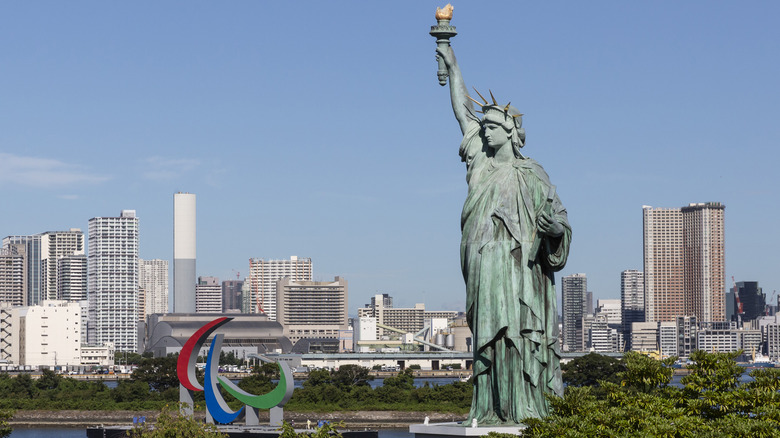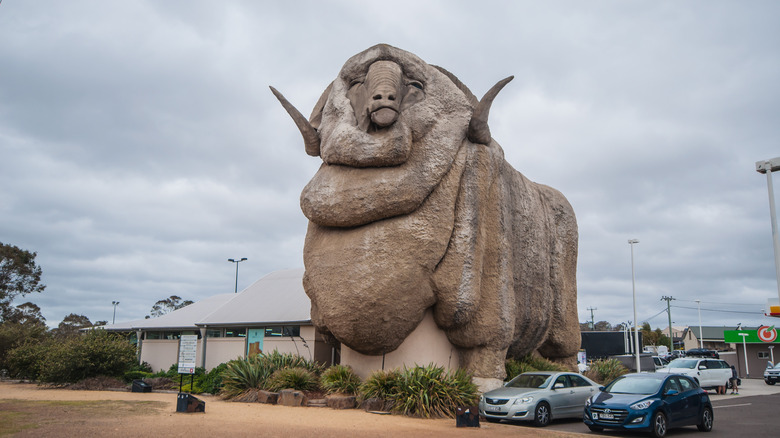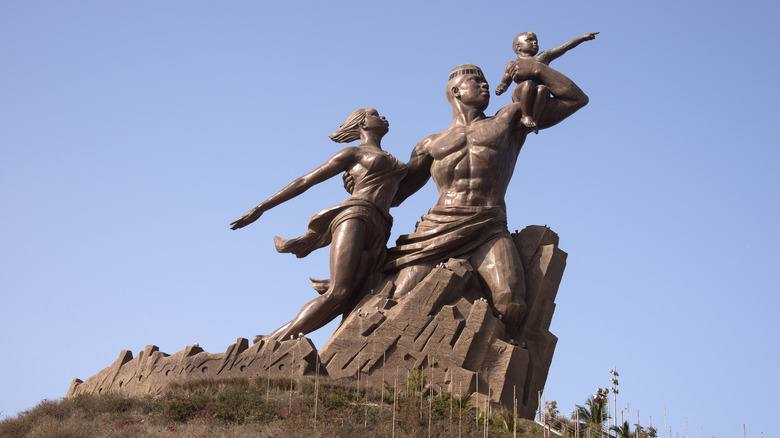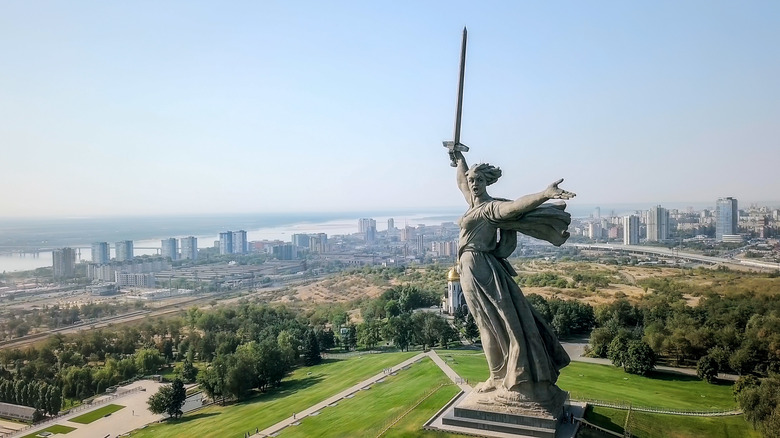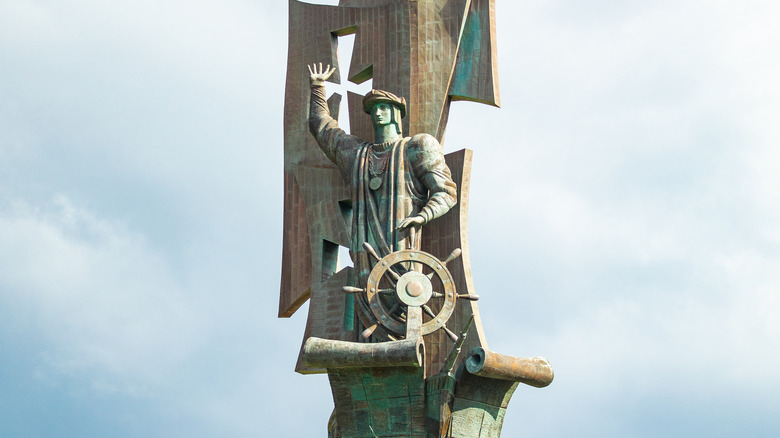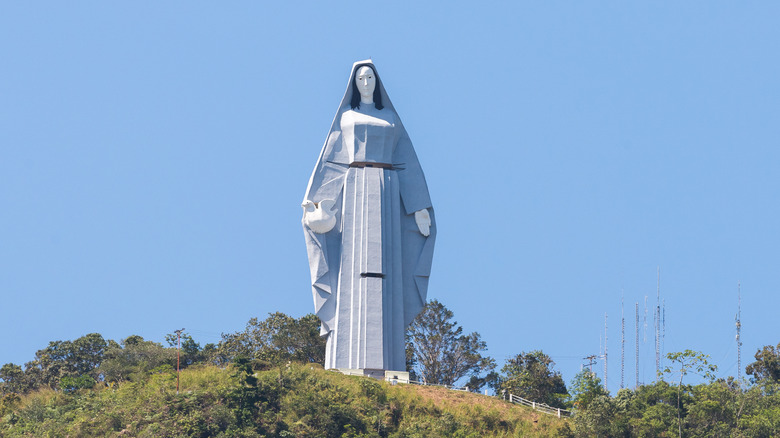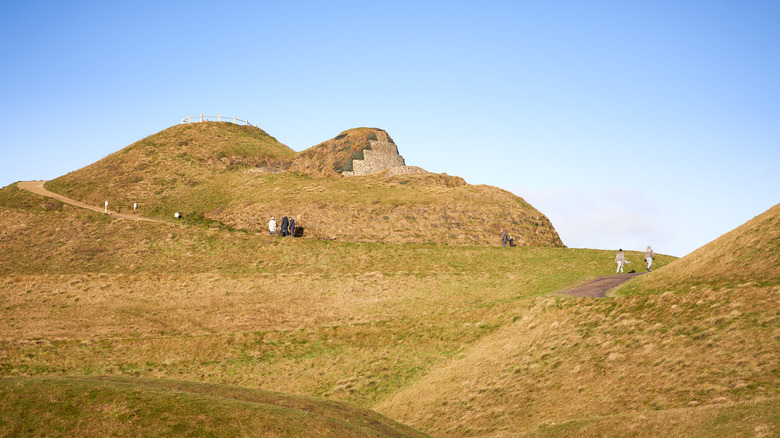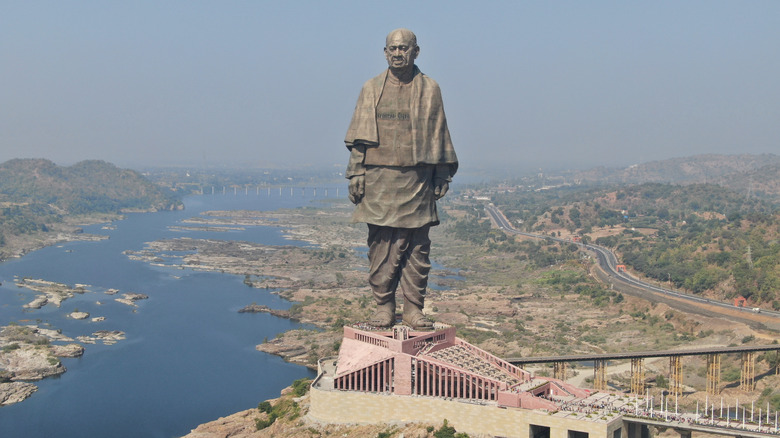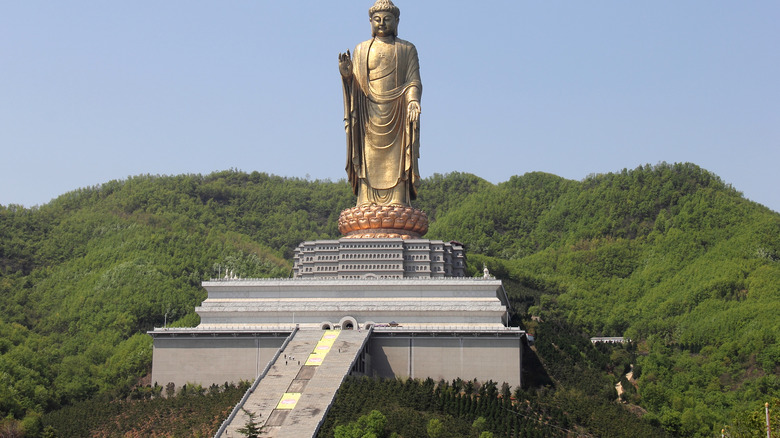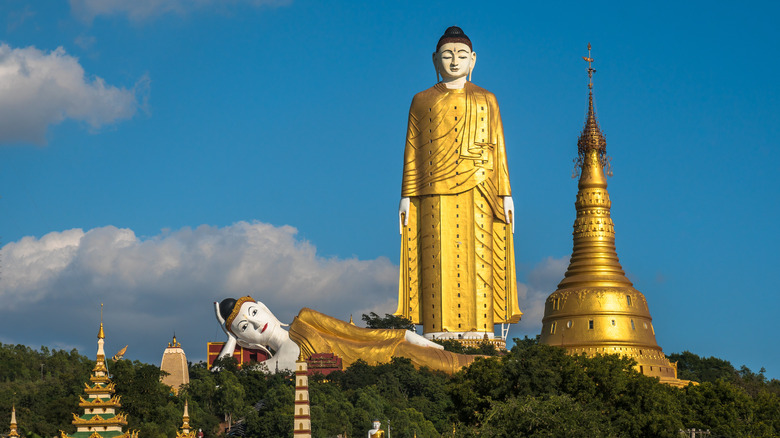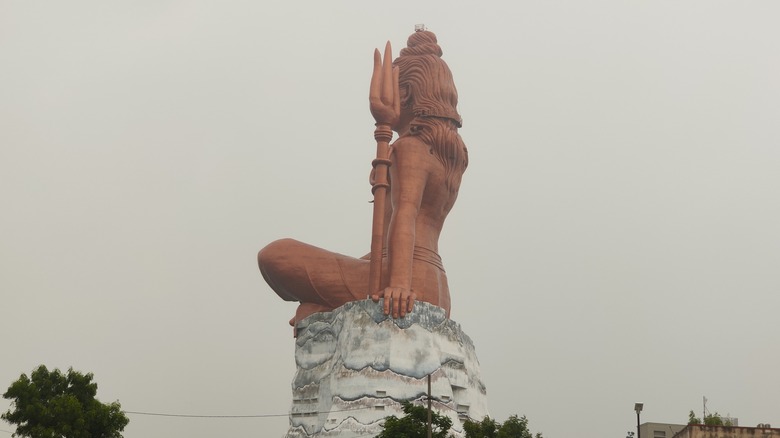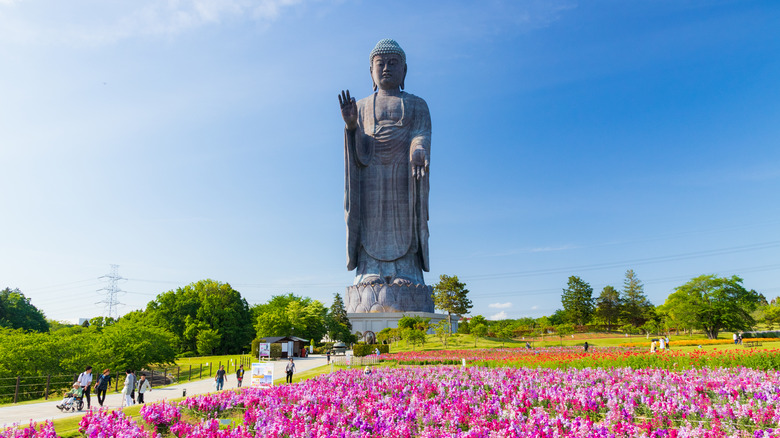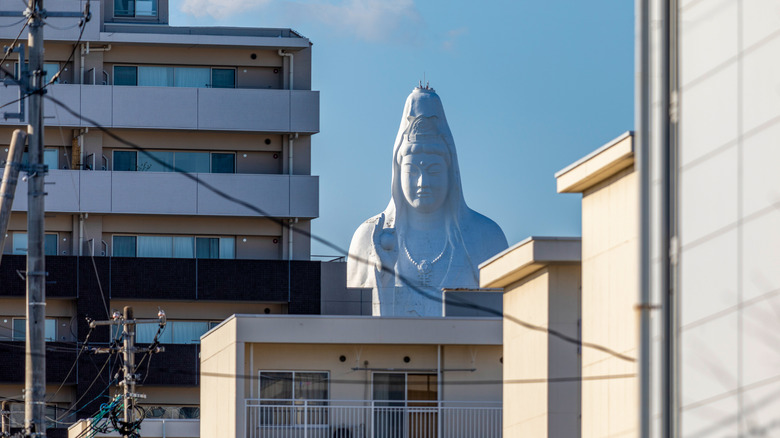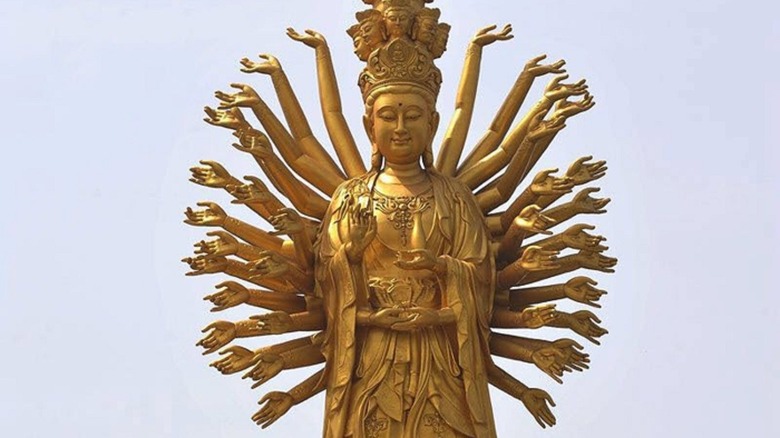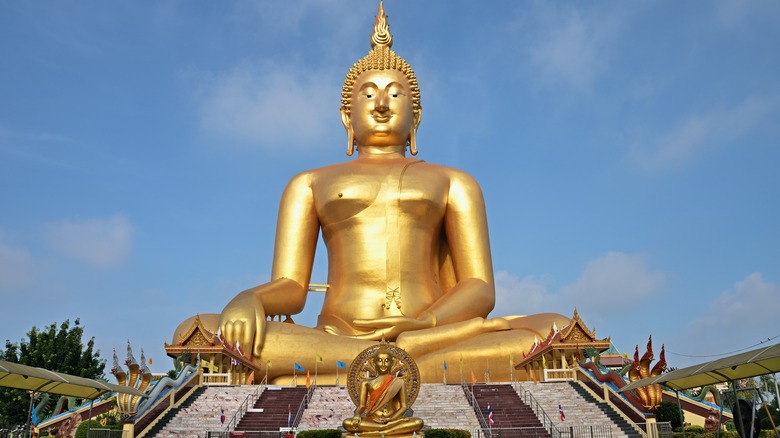The Biggest Statues In The World
If you want to make a statement, build a big statue. Civilizations have been doing it for centuries. One famous statue, as described by Britannica, was the Colossus of Rhodes. Constructed in the third century B.C., it was reportedly over 100 feet high. This sculpture was so large for its time that it was listed as one of the Seven Wonders of the Ancient World.
It seems that as time moves forward, statues get larger, with the idea apparently being to out-Colossus the Colossus. The Statue of Liberty, for example, at 305 feet high (including the pedestal), was dubbed the "New Colossus" by the poet Emma Lazarus. It was the largest statue in the world from its dedication in 1886 until the mid-20th century. Since then, there has been an accelerated spate of building bigger and bigger statues so that now the Statue of Liberty is pretty low on the list of the biggest monuments in the world. This article will survey the most humongous statues around by looking at the biggest in Europe, Africa, Australia, and the Americas before turning to the truly epic ones that have been erected throughout Asia in just the last few decades. It's up for debate whether these statues were built because of Ozymandias-like egos or sincere devotion to a cause or belief. In the end, it may be a bit of both.
Big Merino
Australia is home to some very large and very kitschy sculptures that dominate the highways and byways. According to "National Geographic Traveler: Australia," Australians throughout the country have built a number of loosely associated "Big" sculptures that are compellingly cheesy and awfully effective as tourist traps. For example, there is the Big Crayfish (or Lobster) in South Australia and Queensland's Big Pineapple, each standing more than 50 feet tall.
One of the biggest, and one that hearkens back to Australia's sheep-shearing heritage, is the Big Merino in Goulburn, New South Wales. According to its official site, this epic concrete ram is about 50 feet tall and 60 feet long, with a weight of around 106 tons. The enormous sheep was modeled after a real-life local sheep named Rambo (the statue is nicknamed the same) and finished in 1985.
According to Atlas Obscura, Rambo was originally situated by the Hume Highway, where it acted as a tourist trap. However, Rambo's popularity was threatened in 1992, when the highway was rerouted. Determined locals moved Rambo closer to the new highway, renovated it, and even opened a gift shop on its ground level. Its second floor also contains a permanent exhibition on the two-century history of wool in Australia.
African Renaissance Monument
The biggest statue in Africa has a controversial history. At 160 feet tall, the African Renaissance Monument, located in Senegal, was erected ostensibly to honor the achievements of Africans. As reported by Slate, it was dedicated in 2010 to mark the 50th anniversary of Senegal's independence from France.
According to Atlas Obscura, the statue was first proposed by then-president Abdoulaye Wade, whose administration was besmirched with scandal and accusations of nepotism and corruption. The statue was enmeshed in Wade's troubles. Its price was $27 million, which the government forked over even though the country was suffering economically. It also was designed by non-Africans and built by a North Korean construction firm. The design itself evokes propaganda art worthy of the Soviets, with a well-muscled male clutching a fainting woman with an exposed breast in one arm and holding aloft a pointing babe with the other. Besides the statue's aesthetic failings, it's widely regarded as a colossal (pun intended) waste of money, and the exposed breast is offensive to the country's mostly Muslim population. In addition to all this, the monument is situated amid piles of garbage and dilapidated buildings.
Though Wade fled the country after his defeat in 2012, he has claimed 35% of the revenues generated by visitors to the statue, on the grounds of intellectual property rights.
The Motherland Calls
"The Motherland Calls" in Volgograd, Russia, is Europe's tallest statue and commemorates the Soviet victory at the Battle of Stalingrad (today's Volgograd) during World War II. Atlas Obscura describes how this 279-foot-tall statue depicts a woman dramatically wielding the world's largest sword. There are 200 steps leading up to the base of the statue — one step for each day of the bloody battle.
It was a feat to construct, taking eight years from 1959 to 1967. The pose, as stunning as it is, led to balance problems right away. Later it was found that the 108-foot-long sword, which originally contained titanium sheets, was compromising the statue with its weight. That issue was resolved by replacing the material with stainless steel, but there are other problems: The statue does not connect to the foundation it's built on, and that foundation is being compromised by rising water levels. Fortunately, the statue still stands, although it has a slight list.
Birth of the New World
The largest statue in North America, or the Americas in general, is in Arecibo, Puerto Rico. Architectural Digest reports that "The Birth of the New World" was installed in 2016 and designed by Georgian-Russian painter and billionaire Zurab Tsereteli. The 350-foot statue, which is made of bronze, steel, and copper, depicts Christopher Columbus at the mast of his ship. Its entire weight is 6,500 tons (yes, tons, not pounds), and it took more than 110,000 hours to assemble.
The statue was originally meant to commemorate the 500th anniversary of Christopher Columbus' 1492 landfall in the Americas, but it wasn't installed until years after the anniversary. Perhaps because of its sheer immensity or perhaps because of the controversy concerning the European colonization of the Americas and its impact on Indigenous people, the statue had trouble finding a home. It was initially rejected by cities on the mainland, including Columbus, Ohio, Miami, New York, Boston, Cleveland, and Fort Lauderdale. The Guardian contends that Puerto Rico took in the huge sculpture partially because it hoped to increase tourism to help the island's economy. Since that time, Mother Jones reports that "The Birth of the New World" has been a source of increasing dispute, as native people view the subject as a symbol of genocide, racism, and colonialism.
Monumento a la Virgen de la Paz
The Virgin Mary supposedly appeared in Trujillo, Venezuela, in 1570. Aleteia tells us that, to commemorate the occasion, the government commissioned the Spanish sculptor Manuel de la Fuente in 1983 to build a 153-foot-tall statue of the Virgin Mary on the plateau where the event occurred. Thus, Trujillo became home to the 2.4-million-pound "Virgen de la Paz" ("Virgin of Peace") that overlooks the city, clutching a white dove.
When it was built, it outstripped the Statue of Liberty as the tallest statue in the Americas, and it's still the biggest statue in South America today. According to "Religions of the World," it was the tallest Christian statue in the world as of 2010, for those who like to keep score on these types of statistics. The style of the statue is more modern than the Statue of Liberty, having a less realistic and more geometric aesthetic. Despite being such an imposing piece of art — and the fact that visitors can climb within the statue to different views of the surrounding countryside — Aleteia tells us that the statue does not see as many visitors as other places in the country. So size doesn't always matter.
Lady of the North
Unlike most statues, "The Lady of the North" is an earthen monument that sprawls across the landscape of Northumberland, United Kingdom. This land sculpture, as described by Atlas Obscura, is best appreciated from above, where the sinewy curves of green hills form the figure of a woman. "The Lady of the North," alternatively known as Northumberlandia or simply the Lady, was created by land artist Charles Jencks in 2012 as a park that used the waste, slag, and dirt from the neighboring Shotton Surface Mine. The Lady contains some 1.5 million tons of mine waste and stretches out for about a quarter of a mile. The result is an environmental project that stands in stark contrast to the overused land that surrounds it. While the Lady only reaches a top elevation of 112 feet, if she were to stand up, she would be the tallest sculpture in the world by far.
"The Lady of the North" has met some criticism. The Washington Post reports that some evangelicals have objected to the womanly figure, asserting that it promotes paganism. Tabloids, meanwhile, have fixated on the structure's large breasts. Others view "The Lady of the North" as a figurative symbol of environmental renewal and the vitality that can emerge from the waste of industry.
Statue of Unity
As of this writing, the tallest statue in the world is located in Gujarat, India. The work, which was finished in 2018, is dubbed the "Statue of Unity" and depicts Sardar Vallabhbhai Patel –- a 20th-century Indian independence leader who was important in uniting the various Indian states.
The piece's stats are overwhelming. According to The New York Times, the "Statue of Unity" is 597 feet tall. The toes of the statue dwarf the size of a man — it can be argued that the whole edifice provides less of a unifying feeling than an overwhelming one. Perhaps that was the intention of the artist, Ram V. Sutar, who specializes in these oversized monuments. The New York Times reported he may be the most prolific monumental sculptor in history. The "Statue of Unity" is no doubt Sutar's greatest work, though he told The New York Times that he's regretful that his work has been mainly realist while he has "great ambitions to do Modernist work."
The "Statue of Unity," however, will not remain at the top of the tallest-statue list for long. A larger equestrian statue dedicated to the 17th-century warrior and Maratha king Chhatrapati Shivaji Maharaj is being constructed in Mumbai. According to the statue's design company, this monument will be almost 689 feet tall upon completion.
Spring Temple Buddha
For a decade, the Spring Temple Buddha in the Fodushan Scenic Area in Zhaocun, China, reigned as the world's tallest statue at 502 feet. According to Atlas Obscura, it was constructed between 1997 and 2008 and features a standing Buddha atop a lotus platform, which is then situated on two more structures. Even though the Spring Temple Buddha lost its place as tallest statue to the "Statue of Unity" in 2018, Travel China reports that it's still the tallest Buddhist statue in the world. To illustrate its immensity, the eyes are each over 12 feet wide and the hands almost 30 feet wide.
Why build such a monumental statue? "Buddhism: Understanding Our Religious World" explains that the site was the location of a spring whose water was attributed with healing properties. In fact, the incarnation of the Buddha in this statue is Vairochana, the Great Sun Buddha — or, as Britannica tells us, the "Illuminator," a transcendent supreme Buddha. Aside from its size, the only other disconcerting feature of the Spring Temple Buddha is that there is a swastika on the statue's chest. However, in eastern religions such as Buddhism, Hinduism, and Jainism, this symbol indicates good fortune and prosperity rather than the racist ideologies of the Nazis who adopted it in the early 20th century.
Laykyun Sekkya
Another massive Buddhist statue called the Laykyun Sekkya can be found in Khatakan Taaung, Myanmar (Burma). "Atlas Obscura" describes how this statue of the Buddha was completed in 2008 after 12 years of construction. The gold-bodied and white-faced statue is 381 feet tall, but this elevation is increased by its placement on a 44-foot-high pedestal, for a total height of 427 feet. Lonely Planet explains that a visitor may enter the Buddha and ascend stairs to painted galleries that depict different scenes of Buddhist hells.
What makes this statue unique (aside from its size) is that there is another statue of a reclining Buddha right before it. That statue is 312 feet long, which makes it the longest reclining statue of the Buddha anywhere (for those who are keeping track). You can enter the recumbent Buddha through its right buttock. According to "Atlas Obscura," both statues have their gazes affixed on the stupa of the Aung Sakkya Pagoda.
Unfortunately, visiting these Buddhas is currently inadvisable. Because of recent political unrest and civil war in the country, the U.S. State Department has placed Myanmar on its "do not travel" list.
Statue of Belief
While Buddhist statues can certainly be immense, Hinduism also has its own monumental statues. The largest of these, the Statue of Belief, was built by 750 workers between 2013 and 2020 in Ganesh Tekri in Rajasthan's Nathdwara, India. This is a red-painted statue of Lord Shiva, seated on a platform of zinc and holding an imposing trident. It is, according to the India Times, 351 feet tall and composed of more than 2,700 tons of steel. This makes it the world's tallest Shiva statue. The statue features elevators that go to various viewing galleries. The Statue of Belief also has a surrounding garden area that features a much smaller statue of the sacred bull Nandi.
The Indian Eagle reports that the statue was built in part to attract people to the historic temple town of Nathdwara, which is also the site of a temple that possesses a 5,000-year-old idol of the god Vishnu.
Ushiku Daibutsu
The fifth tallest statue in the world is another big Buddha: the Ushiku Daibutsu, or the Great Buddha of Ushiku, Japan. According to Japan Today, after it was completed in 1995, its 393-foot height made it the largest in the world until it was knocked off its pedestal by China's Spring Temple Buddha. Japan's monumental Buddha is a depiction of the Buddha of Infinite Light, called Amitābha, and was built in honor of Shinran, the founder of the True Pure Land Sect of Mahayana Buddhism.
The statue is a major attraction in Ushiku, drawing more than 600,000 visitors per year. Because of this, its maintenance is strict, with cleaners having to ascend the statue regularly on ropes and scaffolding to scrub various parts of the Great Buddha's metal body over the years. For example, in 2020, workmen concentrated on the immense ears by pressure-washing them to remove grime and bird droppings. It was the first time since its construction that the ear was swabbed.
Sendai Daikannon
Japan's second tallest statue, and the sixth tallest in the world, stands in Sendai. Atlas Obscura tells us this statue is a 328-foot depiction of the bodhisattva Nyoirin Kannon. The Kimbell Art Museum explains that this deity is the Japanese equivalent of Avalokiteshvara, the Indian bodhisattva of compassion who offered love to all beings. Highly popular in Japan, Nyoirin Kannon is venerated by Buddhists in the belief it can bestow wealth and prosperity.
While the monumental statue in Sendai cannot directly offer wealth, it does provide an elevator to the top, where one can look out upon the city. Inside the monument at ground level, there are statues of the various incarnations of the bodhisattva. Across from these, there are demonic statues that represent the months in Chinese astrology. If the elevator is broken, you may ascend the stairs and see 108 statues that show the range of human emotions and worldly desires.
Guishan Guanyin
The Indian deity Avalokiteshvara, which was honored in Japan with the Sendai Daikannon, is also venerated among Chinese Buddhists as the compassionate and merciful Guanyin. According to Britannica, Guanyin was originally worshiped in China starting in the first century A.D. The early depictions of Guanyin were male, but around the 11th century, the form of the bodhisattva changed. Thus, today, Guanyin is typically venerated as a young and beautiful woman. Catholics have compared Guanyin to the Virgin Mary.
In all events, Guanyin is well-respected, and Top China Travel reports that a huge statue, the Guishan Guanyin, has been erected in the Chinese city of Changsha in the Hunan province. This statue, formally known as "Guishan Guanyin of the Thousand Eyes and Hands," is gilded bronze. Standing at nearly 325 feet, it is the seventh tallest statue in the world. Like the name hints, the statue features Guanyin with numerous circling hands.
The Great Buddha of Thailand
Another big Buddha has its home at the Wat Muang Monastery in Tambon Phai Cham Sin, Thailand. Atlas Obscura reports that the statue is 301 feet tall and 206 feet wide, depicting a Buddha in a lotus position. The official name of the statue Buddha is Mahaminh Sakayamunee Visejchaicharn or, unofficially, Phra Buddha Maha Nawamin. But most just call it the Big Buddha. The gold-painted, concrete statue shows a seated Buddha overlooking the surrounding agricultural region.
Visitors can also view the complex around the Big Buddha, which includes the monastery and a garden filled with statues depicting various creatures from Buddhist Hell. Curiously, the monastery itself is a recent construction. The site was once home to an ancient temple, but it was destroyed by the Burmese during an 18th-century war and then reconstructed in 1982. The Big Buddha was probably commissioned to honor the temple, with work beginning in 1990 and continuing until its completion in 2008.
